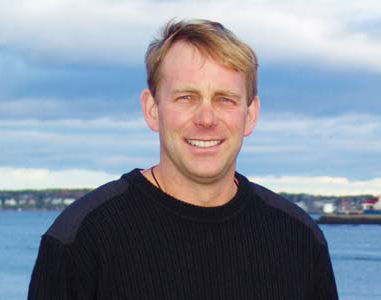 Dr. Mark Green knows the tiniest marine organisms can tell us a lot. As carbon dioxide levels in the atmosphere have climbed steadily – making the ocean more acidic in the process – he was the first scientist to prove tiny juvenile clams were dying primarily because their shells were dissolving in less alkaline conditions. Now, the National Science Foundation has honored his pioneering contributions by awarding the marine science professor a third grant to continue his research related to the effects of ocean acidification on clams.
Dr. Mark Green knows the tiniest marine organisms can tell us a lot. As carbon dioxide levels in the atmosphere have climbed steadily – making the ocean more acidic in the process – he was the first scientist to prove tiny juvenile clams were dying primarily because their shells were dissolving in less alkaline conditions. Now, the National Science Foundation has honored his pioneering contributions by awarding the marine science professor a third grant to continue his research related to the effects of ocean acidification on clams.
Over the next three years of the $500,000 grant, Green will turn his focus on microscopic larval clams in several Maine estuaries, where changes in acidification happen much faster. “It’s the best environment to study the effects of acid burdens that are caused by increased carbon dioxide from atmospheric pollution and groundwater runoff,” says Green. “Estuaries are less buffered to acid than the open ocean, but acidification research has not focused there until now.”
Green’s research has garnered attention from many corners, both academic and in the wider press. His work showed that in more acidic sediments, the shells of juvenile clams dissolve, leading to massive die off of the young. It proved – contrary to scientific opinion at the time – that predation was not the primary factor responsible for the die offs, but rather was a result of an underlying condition in the sediments where young clams burrow.
Through an experiment that manipulated the pH of sediment, he also discovered some juvenile clams avoid burrowing in mud that is too acidic, leaving them exposed to predators.
“The data’s really cool,” he says excitedly, graphing a curve that perfectly shows the negative correlation between acidic sediment and burrowing. “They would rather risk predation than burrow there,” he notes.
Because his work changed the paradigm about clam survival, it changed the direction of other people’s research. In the last five years, ocean acidification has come to the forefront of the marine science community. Though Green didn’t discover ocean acidification per se, his was one of the first data sets to clearly show its effect. He calls ocean acidification “the other CO2 problem,” and believes it may be more significant than climate change because of its potential effect on plankton, which feeds the entire marine food chain.
Indeed, leading experts at the 2009 Aspen Environment Forum called ocean acidification a “planet changer.” When Green was interviewed on Maine Public Radio late last year, he told the reporter that acid concentrations in the ocean have increased by 30 percent, mostly over the last several decades. “The signal is clear. The data is robust,” he warned.
In the new experiments, Green will focus on how varying pH levels in mudflat sediments affect where larval clams settle and burrow. He will also look at the water column itself, measuring water chemistry in Casco Bay to determine if larval clams are likely to face conditions where their shells would dissolve during the annual spawn. Preliminary field work required for this funding showed that the pH of Casco Bay is at its annual lowest during the exact period when larval bivalves are found in the water.
Green will mimic the water chemistry found in Casco Bay back in the lab, raise larvae of several clam species in the simulated environment, and measure indices of their health and survivorship. He also plans to expand his innovative technique to counter acidic conditions in the mudflats: adding crushed clam shells to the sediments.
In an earlier finding, Green discovered that adding the crushed shells boosted the survival rate of juvenile clams because the calcium carbonate from the crushed shells slightly raised the pH to more alkaline conditions. This time he will work calcium carbonate into sediments over a broad area and monitor the cohort of settling clams over a longer period (two years), to the point when they become commercially viable. By comparing these measurements to control sediments, Green will assess the viability of large-scale buffering projects as a cost-effective way to increase natural populations of bivalves in the mud flats.
As part of the study, a colleague at the University of New Hampshire, Dr. Joe Salisbury, will develop a diagnostic model for the shellfish management community to predict future populations of commercially important bivalves based on water column acidity when their larva are in the water.
Dr. Green’s concern for the fate of these bivalves reflects his view that ocean acidification is a looming catastrophe with vast ecosystem implications. In December, that concern propelled him to Washington, D.C., to discuss the issue with Congressional representatives at the request of the National Fisheries Conservation Center. Green says he wants to build awareness about the tiny, vulnerable organisms that tell us so much about big environmental changes – and why protecting them protects all of us.



